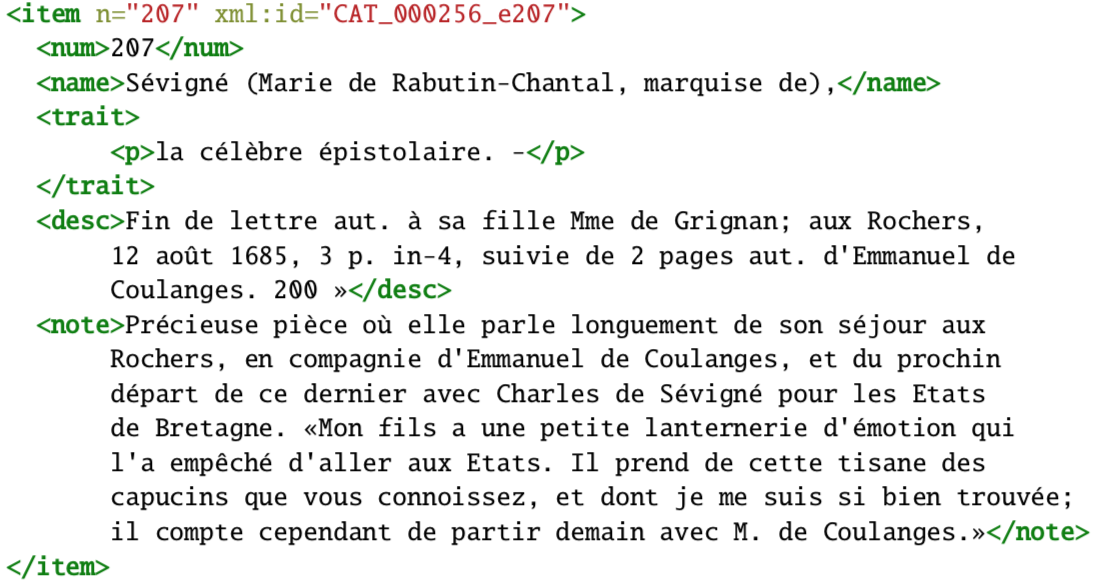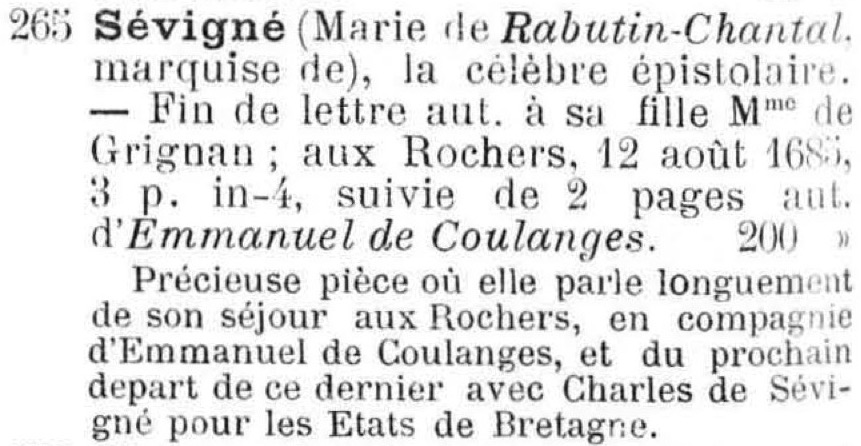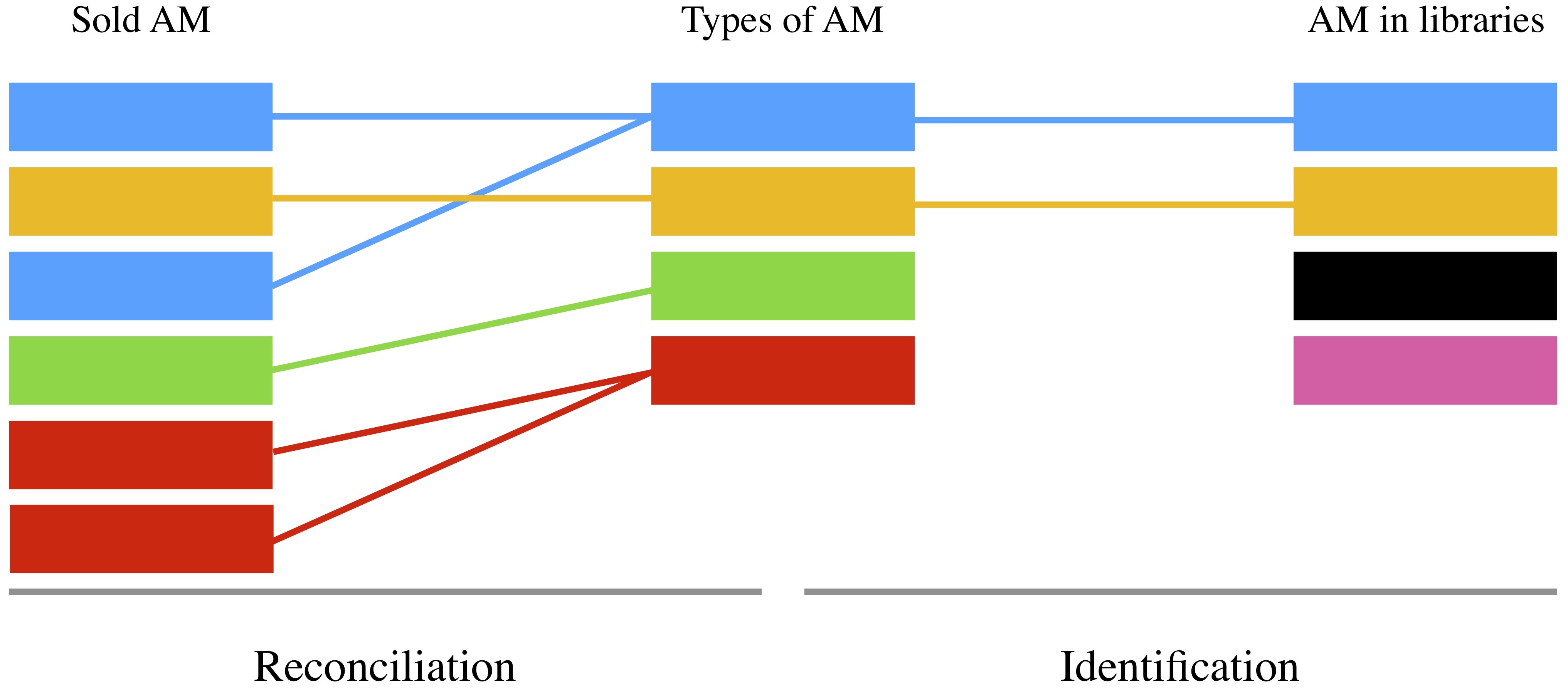1. Abstract
Manuscripts can be burned, lost, forgotten, thrown away... If scholars have already tried to measure the proportion that has survived since the apparition of moveable types with Gutenberg [Weitzman, 1987], such percentages do not help editors of texts to answer a more practical question: how many documents of a given author still exist, and among them how many are accessible to scholars?
In the present paper, we want to use Madame de Sévigné (1626-†1696) as a test case to calculate how many autograph manuscripts (AM) are still circulating on the market, and therefore assess precisely what is inaccessible because it is held in private collections by combining three different sources of information. First, a list of French AM held in libraries – which has been created for the occasion, because there is no catalogue for French literature such as the one by P. Beal [2005]. Second, a list of Sévigné’s AM held in historical private collections, drawn from Duchêne’s edition [Sévigné, 1972-1978]. Third, a list of manuscripts drawn from fixed-price and auction catalogues [Bodin, 2000], which contains the description of hundreds of thousands of manuscripts sold over decades (fig. 1).
1. Quantification
Existing manuscripts (E) of an author (a) are either kept accessible in libraries and archives (L), either (more or less) hidden in private collections (C).
![]() (1)
(1)
The problem is that while we know L, for which we have catalogues, C is unknown. To know what it represents, we can divide it in two: on the one hand we have historical collections (H), usually inherited by old families, well documented and extremely static, and on the other hand there is an unknown amount of documents circulating between private collectors (P).
![]() (2)
(2)
If we cannot know P, we can use a proxy: we can deduce what is still on the market (M) by subtracting what is owned (because it has been bought) by libraries (L) from everything that has been sold (S).
![]() (3)
(3)
Because buyers are constantly intervening on the market (S), any value is only true at time t – i.e. the date of the last sale catalogue taken into account, assuming that all the previous ones have been analysed.
![]() (4)
(4)
With all these information, we can now deduce how many manuscripts still exist (E) if we know S.
![]() (5)
(5)
2 Extraction and structuring


Figure 1: RDA, May 1894 (N°166)
Looking for French AM, we have concentrated our efforts on documents sold in Paris, and for financial and time reasons, we have focused on catalogues published before c. 1900. We have retro-converted:
- 250 fixed-price catalogues of the Revue des autographes (RDA, cf. fig. 1).
- 300 fixed-price catalogues of the Lettres autographes et documents (LAD).
- 100 auction catalogues.
Because of similarities between such catalogues and dictionaries, we have been able to use GROBID dictionaries [Khemakhem et al., 2018] to process the images and transform them into a fully TEI-conformant semantic encoding (fig. 2) thanks to a custom workflow [Gabay et al., 2020].

Figure 2: XML-TEI encoding of an entry
The workflow keeps undergoing constant improvements (e.g. Rondeau Du Noyer et al. [2019]), which have led to the creation of a dedicated tool for catalogues [Khemakhem et al., 2020]. In its last version, on top of traditional features for information extraction (special characters, position on the page... in red in fig. 3), we now use typographical information (bold, italics, size of the font... in blue in fig. 3) for more precise results.

Figure 3: RDA, May 1873 (N°37)
3 Annotation and reconciliation
The letter previously mentioned is not the only one of Sévigné sold during the 19th c., and it has not been sold only once:

Figure 4: RDA, July 1897 (N°200)

Figure 5: RDA, April 1902 (N°257)
Because the same item can be sold multiple times, it is crucial to transform the list obtained with the digitisation of sale catalogues into a set of unique types (or classes, cf. blue and red boxes in fig. 6), prior to comparing these types with existing documents held in libraries. Doing so, we can identify AM that have never appeared on the market (in pink and in black), document the history of those that are now in library collections (in blue and in orange) or identify “ghost” manuscripts that are still circulating on the private market (in green and red).

Figure 6: Reconciliation-identification process
To carry out this task, more information is required than those provided by GROBID dictionaries, we have therefore added an extra layer of information, including the type of document (L.a.s. for autograph letter signed, D.s. signed document...), its length (number of pages or folios...), its format (in-octavo, in-quarto...), its date or its price. Since these information follow either an extremely strict (1 p., L.a.s.... ), either a fairly common pattern (12 janvier 1798, 19 sep. 1820...), they are tagged with regexes and dedicated python libraries in order to obtain a more fine-grained encoding:

Figure 7: Annotated
Combined with the name of the author, such information provide a unique combination of features that can be used to compare sold documents over time, and identify not only same AM sold twice, but also different fragments of a single manuscript (tab. 1), which share part of the information only (same date, same format but different length).

Table 1: Key information of three sold items from catalogues
Because we have catalogued all the known manuscripts of the marquise de Sévigné after extensive research in European and American libraries, it is possible to reconstitute part of their history thanks to the sale catalogues.

Table 2: Key information of two manuscripts
4 Results
We can now offer some results:
- 63 sales have been identified until 1903
- 46 AM being sold at least one time, 14 at least two times
- 13 letters out of the 46 sold are not in public libraries or archives
Following these numbers, we can say that:
- c. 1% of the 1,350 letters identified by Duchêne [Sévigné, 1972-1978] are still circulating on the market.
- c. 5% of the total has survived but is inaccessible to scholars, if we add the 62 letters still held in the private collections of the Guitaut family in Burgundy.
Such numbers, obviously, need to be taken with caution for two main reasons. On the one hand, the oldest catalogues are not precise enough to identify exactly which AM is sold. On the other hand, the market in the 19th c. is already international, and manuscripts sold outside of France are not taken into account by our study. This second problem should receive all our attention in a near future to contribute to the history of objects [Courtin, 2020], and especially the migration of manuscripts [Burrows et al., 2019].
Acknowledgements
Many thanks to Agathe Decaster for her (crucial) help with the mathematical formulas, and her brother Erwan.
References
P. Beal. Catalogue of English Literary Manuscripts 1450–1700, 2005. URL https://celm-ms.org.uk/. https://celm-ms.org.uk.
T. Bodin. Les grandes collections de manuscrits littéraires. In A. Charon and E. Parinet, editors, Les Ventes de livres et leurs catalogues: XVIIe-XXe siècle, number 5 in Études et rencontres, pages 169–190. École des chartes, Paris, 2000.
T. Burrows, E. Hyvönen, L. Ransom, and H. Wijsman. Mapping manuscript migrations: Digging into data for the history and provenance of medieval and renaissance manuscripts. Manuscript Studies, 3(1), May 2019. URL https://repository.upenn.edu/mss_sims/vol3/iss1/13.
A. Courtin. Retour sur la datavisualisation « Sur la pistes des ventes d’antiques ». Numérique et recherche en histoire de l’art, 2020. URL https://numrha.hypotheses.org/743.
S. Gabay, L. Rondeau Du Noyer, and M. Khemakhem. Selling autograph manuscripts in 19th c. Paris: digitising the Revue des Autographes. In Atti del IX Convegno Annuale AIUCD. La svolta inevitabile: sfide e prospettive per l’Informatica Umanistica, Quaderni di Umanistica Digitale, pages 113–118, Milan, Italy, 2020. Associazione per l’Informatica Umanistica e la Cultura Digitale. https://hal.archives-ouvertes.fr/hal-02388407.
M. Khemakhem, A. Herold, and L. Romary. Enhancing Usability for Automatically Structuring Digitised Dictionaries. In GLOBALEX workshop at LREC 2018, Miyazaki, Japan, May 2018. URL https://hal.archives-ouvertes.fr/hal-01708137.
M. Khemakhem, S. Gabay, B. Joyeux-Prunel, L. Romary, L. Saint-Raymond, and L. Rondeau Du Noyer. Information Extraction Workflow for Digitised Entry-based Documents. In DARIAH Annual event 2020, Zagreb, Croatia, 2020. Digital Research Infrastructure for the Arts and Humanities. URL https://hal.archives-ouvertes.fr/hal-02508549.
L. Rondeau Du Noyer, S. Gabay, M. Khemakhem, and L. Romary. Scaling up Automatic Structuring of Manuscript Sales Catalogues. In What is text, really? TEI and beyond, Graz, Austria, Sept. 2019. URL https://hal.inria.fr/hal-02272962. https://hal.inria.fr/hal-02272962.
Sévigné. Correspondance. Gallimard, Paris, 1972-1978. ed. by R. Duchêne.
M. P. Weitzman. The Evolution of Manuscript Traditions. Journal of the Royal Statistical Society. Series A (General), 150(4):287–308, 1987. ISSN 0035-9238. doi: 10.2307/2982040. https://www.jstor.org/stable/2982040.